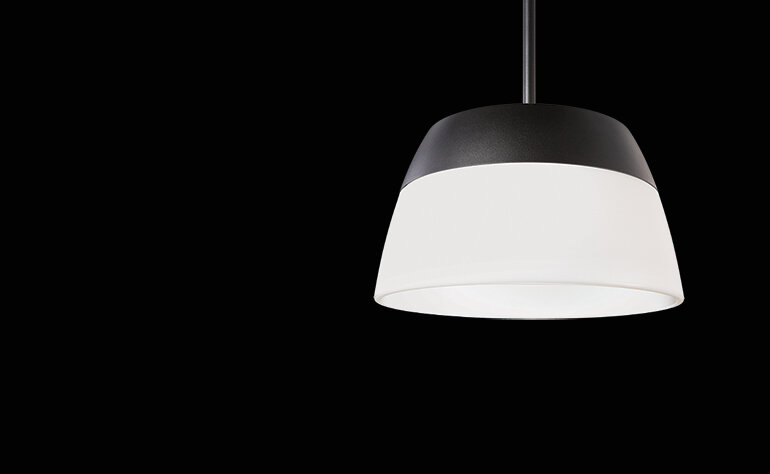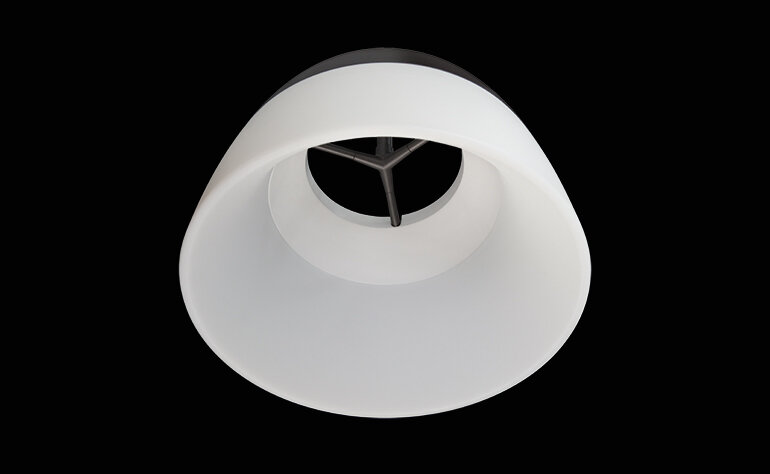This month's fixture of the month goes to a manufacturer based in the Bay Area called Glint. They have developed a niche product for gallery spaces that elevate the experience of lighting art. the Hero is a track fixture with a fixed angle profile. On the face of the fixture, there are individual LED nodes with optics visible. What makes this fixture different from its competitors is the small joystick located on the end of the fixture in one of the locations where an LED would be located. With the joystick, you can aim the lights to your desired location without needing to move the fixture itself. What you end up with is a much cleaner appearance in the ceiling with all of the fixtures oriented the same way. They offer varying beam optics as well as color temperatures. This fixture is an exciting new option in the world of art lighting and will definitely change how we look at the capabilities of LEDs moving forward.
Fixture of the month: Luminis Hollowcore
Luminis has come out with Hollowcore which is an updated version of a classic that brings a fresh modern look to projects. Highbays have been used for years to light large spaces. With the prevalence of LEDs, there have been retro-fit versions of LED highbays before but they all took the existing design of the highbay and plugged in an LED board without thinking of how the technology and optics differ. What I love about the Hollowcore is that it reimagines how the lens can be integrated with the LEDs. It provides a sleek design while controlling the glare of the LED diodes perfectly.
Photo credit: Luminis
Color Temperature Woes
What drives me the craziest is when I walk into a space and see a rainbow of light when all of the lights are technically white.
The problem with color temperature consistency is that there is no standardization that regulates how manufacturers are creating their phosphors for the LEDs. This results in a varying appearance in color. You can have several manufacturers who all claim to have a neutral 3000K color temperature but when you look more closely at them all together, you can start to see some shifts in what that “white” light actually appears to be. You can often see pink hues and green hues in the white light.
One instance where this becomes an issue is when you have retro-fit lamps that are replaced as they fail throughout their lifespan. They will be replaced by whoever is in charge of maintenance and not always will be replaced with the original manufacturer. As the lights are changed out and some are left alone, you can start seeing a shift in the appearance of color almost like a rainbow of white. It can become very distracting and draw away from the polished look of a complete design.
One thing I strive to maintain on a project is consistency. A great lighting design concept will ideally have a series of layered lighting. This leads to having multiple light sources in one space and can open you up to potentially having various hues of the same color temperature. To try and mitigate that, I try to stay within the same manufacturer when possible. It’s helpful to find out which LED is being used to try and keep within consistency if you have to switch across various manufacturers. Another thing I keep in mind when I’m considering how light will be rendered is the types of materials. If I have varying materials within a space, the differences in color temperature are not as noticeable as they are in a room where all of the surfaces are white.
Knowing how light will effect materials is one of the most important roles a lighting designer has. It is important to test out fixtures and have mockups when you can.
You need a lighting designer.
I am an architectural lighting designer. The most common reaction I get when someone hears my job title is first a look of understanding when they hear the word “architectural” followed by clear confusion at the rest of the words “lighting designer”. While my role in the construction world is little known, it is an important piece to realizing a successfully built project.
What is lighting design and why do you need a lighting designer? Lighting design is the art of enhancing an architectural space through the use of light and control. When used properly, lighting has the ability to not only serve the user’s needs but also to create an emotional reaction to the environment.
A lighting designer takes the important pieces of the project including the scope and specific tasks for each space and creates a detailed plan that enhances the built environment. This includes a plan for the placement of the lighting, specific fixtures to be used as well as coordinating any special architectural details that will bring a special element to the spaces.
The importance of having a specialized lighting professional on a project is to have someone who is dedicated to solving the problems inherent to lighting a space. The most successful projects happen when a collaborative team comes together with a skilled architect at the helm. These days, lighting technology is constantly evolving and growing in terms of capability and sources. One of the pieces that a dedicated lighting designer brings to the table is the ability to stay on top of these changes and to understand how they impact the design.
I am Shanna Snow, an Architectural Lighting Designer, and the owner of Shanna Snow Design. Follow along to see how I use my passion for light and love of architecture to build a brighter tomorrow.





